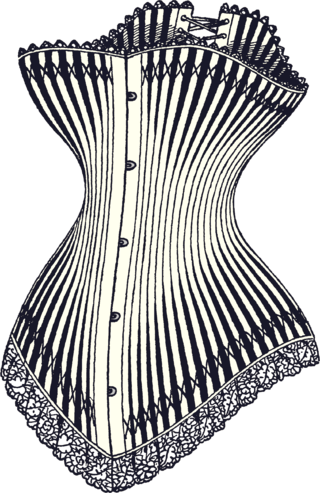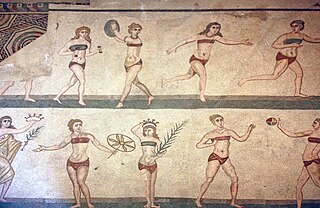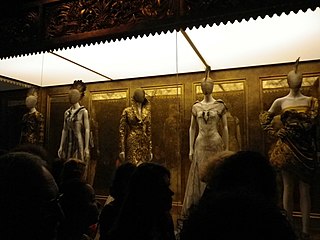
Fetish fashion is any style or appearance in the form of a type of clothing or accessory, created to be extreme or provocative in a fetishistic manner. These styles are by definition not worn by the majority of people; if everyone wears an item, it cannot have fetishistic, special nature. They are usually made of materials such as leather, latex or synthetic rubber or plastic, nylon, PVC, spandex, fishnet, and stainless steel. Some fetish fashion items include: stiletto heel shoes and boots, hobble skirts, corsets, collars, full-body latex catsuits, stockings, miniskirt, crotchless underwear, jockstraps, diapers, garters, locks, rings, zippers, eyewear, handcuffs, and stylized costumes based on more traditional outfits, such as wedding dresses that are almost completely see-through lace, or lingerie for men.

A corset is a support garment commonly worn to hold and train the torso into a desired shape, traditionally a smaller waist or larger bottom, for aesthetic or medical purposes, or support the breasts. Both men and women are known to wear corsets, though this item was for many years an integral part of women's wardrobes.

Christian Ernest Dior was a French fashion designer, best known as the founder of one of the world's top fashion houses, Christian Dior SE, which is now owned by parent company LVMH. His fashion houses are known all around the world, having gained prominence "on five continents in only a decade."

Tightlacing is the practice of wearing a tightly laced corset. It is done to achieve cosmetic modifications to the figure and posture or to experience the sensation of bodily restriction.

A crinoline is a stiff or structured petticoat designed to hold out a skirt, popular at various times since the mid-19th century. Originally, crinoline described a stiff fabric made of horsehair ("crin") and cotton or linen which was used to make underskirts and as a dress lining. The term crin or crinoline continues to be applied to a nylon stiffening tape used for interfacing and lining hemlines in the 21st century.

Paul Poiret was a French fashion designer, a master couturier during the first two decades of the 20th century. He was the founder of his namesake haute couture house.
In corsetry, a bone is one of the rigid parts of a corset that forms its frame and gives it rigidity. The purpose of the boning in a corset varies slightly from era to era. Generally, the cinching/shaping properties of corsetry puts strain onto the fabric from which the corset is made. The boning supports the desired shape and prevents wrinkling of the corset fabric. Bones, and the substances used for the purpose, are generically called "boning"; however, the name likely arises from the use of whalebone in early corsets.

Fashion in the 1890s in European and European-influenced countries is characterized by long elegant lines, tall collars, and the rise of sportswear. It was an era of great dress reforms led by the invention of the drop-frame safety bicycle, which allowed women the opportunity to ride bicycles more comfortably, and therefore, created the need for appropriate clothing.

Charles Wilson Brega James was an English-American fashion designer. He is best known for his ballgowns and highly structured aesthetic. James is one of the most influential fashion designers of the 20th century and continues to influence new generations of designers.
Mainbocher is a fashion label founded by the American couturier Main Rousseau Bocher, also known as Mainbocher. Established in 1929, the house of Mainbocher successfully operated in Paris (1929–1939), and then in New York (1940–1971).

The history of bras is closely tied to the social status of women, the evolution of fashion, and shifting views of the female body over time.

Metal corsets are a type of historical corset or bodice made entirely out of metal, usually iron or steel. The metal corset was popularly claimed to have been introduced to France by Catherine de' Medici in the 16th century, although this is now considered a myth. The idea that such garments were worn for fashionable purposes is debatable, with fashion historians now regarding such claims sceptically. Many of the original metal bodices that have survived are now believed to have been intended for medical purposes as orthopaedic support garments and back braces. Such garments were described by the French army surgeon Ambroise Paré in the 16th century as a remedy for the "crookednesse of the Bodie."
Bonnie Cashin was an American fashion designer. Considered a pioneer in the design of American sportswear, she created innovative, uncomplicated clothing that catered to the modern, independent woman beginning in the post-war era through to her retirement from the fashion world in 1985.

Vera Huppe Maxwell was an American pioneering sportswear and fashion designer.

Underwear, underclothing, or undergarments are items of clothing worn beneath outer clothes, usually in direct contact with the skin, although they may comprise more than a single layer. They serve to keep outer clothing from being soiled or damaged by bodily excretions, to lessen the friction of outerwear against the skin, to shape the body, and to provide concealment or support for parts of it. In cold weather, long underwear is sometimes worn to provide additional warmth. Special types of undergarments have religious significance. Some items of clothing are designed as undergarments, while others, such as T-shirts and certain types of shorts, are appropriate both as underwear and outerwear. If made of suitable material or textile, some underwear can serve as nightwear or swimwear, and some undergarments are intended for sexual attraction or visual appeal.

The Worcester Corset Company Factory is an historic factory building at 30 Wyman Street in Worcester, Massachusetts in the Main South neighborhood. The oldest part of the factory was built in 1895, with expansion of the facilities taking place up to 1909. The buildings were designed by Arthur F. Gray for the Worcester Corset Company, whose origins date to an 1861 business by David Hale Fanning making hoops for skirts, but shifted to manufacturing corsets after fashions changed. Fanning's business was immensely successful, and he became one of Worcester's larger employers. At one point it employed over 2000 women. After the Corset Company folded in 1940, the facility was used to manufacture military-style boots. The factory is now an apartment complex.

The Kraus Corset Factory is a historic industrial property at 33 Roosevelt Drive in Derby, Connecticut. The oldest portion of the large brick building, built in 1879, faces Third Street, while a c. 1910 addition extends along Roosevelt Drive. It is the only major building to survive from Derby's period of corset manufacturing. It was built by Sidney Downs, one of Derby's leading businessmen of the period. The building was listed on the National Register of Historic Places on February 12, 1987. It has been converted into apartments.
Silhouette is an English manufacturer of women's lingerie. It was founded in 1887.

The Anna Wintour Costume Center is a wing of the Metropolitan Museum of Art's main building in Manhattan that houses the collection of the Costume Institute, a branch of the museum focused on fashion and costume design. The center is named after Anna Wintour, the longtime and current editor-in-chief of Vogue, Chief Content Officer of Condé Nast, and chair of the museum's annual Met Gala since 1995. It was endowed by Lizzie and Jonathan Tisch. As of August 2017, the chief curator is Andrew Bolton.
Mr. Pearl is a noted corsetmaker of the late 20th and early 21st century.
















